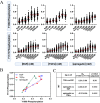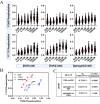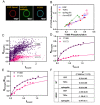Quantification of ligand and mutation-induced bias in EGFR phosphorylation in direct response to ligand binding
- PMID: 37989743
- PMCID: PMC10663608
- DOI: 10.1038/s41467-023-42926-8
Quantification of ligand and mutation-induced bias in EGFR phosphorylation in direct response to ligand binding
Abstract
Signaling bias is the ability of a receptor to differentially activate downstream signaling pathways in response to different ligands. Bias investigations have been hindered by inconsistent results in different cellular contexts. Here we introduce a methodology to identify and quantify bias in signal transduction across the plasma membrane without contributions from feedback loops and system bias. We apply the methodology to quantify phosphorylation efficiencies and determine absolute bias coefficients. We show that the signaling of epidermal growth factor receptor (EGFR) to EGF and TGFα is biased towards Y1068 and against Y1173 phosphorylation, but has no bias for epiregulin. We further show that the L834R mutation found in non-small-cell lung cancer induces signaling bias as it switches the preferences to Y1173 phosphorylation. The knowledge gained here challenges the current understanding of EGFR signaling in health and disease and opens avenues for the exploration of biased inhibitors as anti-cancer therapies.
© 2023. The Author(s).
Conflict of interest statement
The authors declare no competing interests.
Figures





Similar articles
-
Probing phosphorylation events in biological membranes: The transducer function.Biochim Biophys Acta Biomembr. 2024 Oct;1866(7):184362. doi: 10.1016/j.bbamem.2024.184362. Epub 2024 Jun 15. Biochim Biophys Acta Biomembr. 2024. PMID: 38885782 Review.
-
Laser capture microdissection and protein microarray analysis of human non-small cell lung cancer: differential epidermal growth factor receptor (EGPR) phosphorylation events associated with mutated EGFR compared with wild type.Mol Cell Proteomics. 2008 Oct;7(10):1902-24. doi: 10.1074/mcp.M800204-MCP200. Epub 2008 Aug 6. Mol Cell Proteomics. 2008. PMID: 18687633 Free PMC article.
-
Fulvestrant regulates epidermal growth factor (EGF) family ligands to activate EGF receptor (EGFR) signaling in breast cancer cells.Breast Cancer Res Treat. 2013 Jun;139(2):351-60. doi: 10.1007/s10549-013-2541-y. Epub 2013 May 18. Breast Cancer Res Treat. 2013. PMID: 23686416 Free PMC article.
-
Differential activation of epidermal growth factor (EGF) receptor downstream signaling pathways by betacellulin and EGF.Endocrinology. 2004 Sep;145(9):4232-43. doi: 10.1210/en.2004-0401. Epub 2004 Jun 10. Endocrinology. 2004. PMID: 15192046
-
Membrane-anchored growth factors, the epidermal growth factor family: beyond receptor ligands.Cancer Sci. 2008 Feb;99(2):214-20. doi: 10.1111/j.1349-7006.2007.00676.x. Cancer Sci. 2008. PMID: 18271917 Free PMC article. Review.
Cited by
-
Differential association of EphA2 intracellular regions in biased signaling.J Biol Chem. 2025 Apr;301(4):108383. doi: 10.1016/j.jbc.2025.108383. Epub 2025 Mar 4. J Biol Chem. 2025. PMID: 40049409 Free PMC article.
-
In Vitro evaluation of the anti-pancreatic cancer activity of epimedium herb.Front Pharmacol. 2024 Jul 1;15:1389221. doi: 10.3389/fphar.2024.1389221. eCollection 2024. Front Pharmacol. 2024. PMID: 39011503 Free PMC article.
-
Probing phosphorylation events in biological membranes: The transducer function.Biochim Biophys Acta Biomembr. 2024 Oct;1866(7):184362. doi: 10.1016/j.bbamem.2024.184362. Epub 2024 Jun 15. Biochim Biophys Acta Biomembr. 2024. PMID: 38885782 Review.
-
Allosteric modulation of NF1 GAP: Differential distributions of catalytically competent populations in loss-of-function and gain-of-function mutants.Protein Sci. 2025 Feb;34(2):e70042. doi: 10.1002/pro.70042. Protein Sci. 2025. PMID: 39840811 Free PMC article.
References
Publication types
MeSH terms
Substances
Grants and funding
LinkOut - more resources
Full Text Sources
Medical
Research Materials
Miscellaneous

